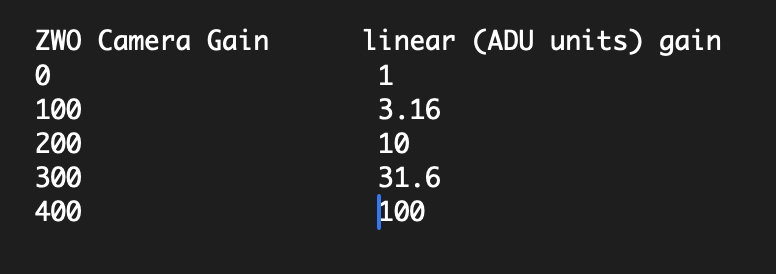thomas_harms Does this correspond to the gain values 0, 100 and 300?
ZWO uses a "gain" value that corresponds to 0.1 dB per ZWO gain unit. I.e., it is based on logarithm based 10 (deciBels); QHYCCD for example has a different gain unit, and is based on the natural log (logarithm based e).
So, a gain of 0 would correspond to a linear gain (in ADU units) of 1. A gain of 200 (20 dB) would correspond to a power gain of 100 or a linear gain of 10 -- thus a ZWO camera gain of 100 (10 dB) would correspond to a linear gain of square root of 10, or 3.16.
A gain of 300 (30 dB) can be thought of as a sum of 20 dB + 10 dB, and thus corresponds to a linear gain of 10 x 3.16, or 31.6.
Here is a table in case you are not familiar with dB scales

What you can do is to point the telescope in the daytime to the sky, through some diffused attenuators (a.k.a. T-shirts). Set the gain to 0, and set the exposure time so you get an average ADU reading of around 8000. Now change the gain to "1", without changing the exposure time -- does the average ADU now read about 8000x3.16? If so, "1" represents a linear gain of 3.16 (10 dB), or a ZWO camera gain of 100.
Do the same to measure the NINA gain of "2." There should be a change in average ADU of a factor of 10 between ZWO camera gain of 100 and ZWO camera gain of 300.
Chen